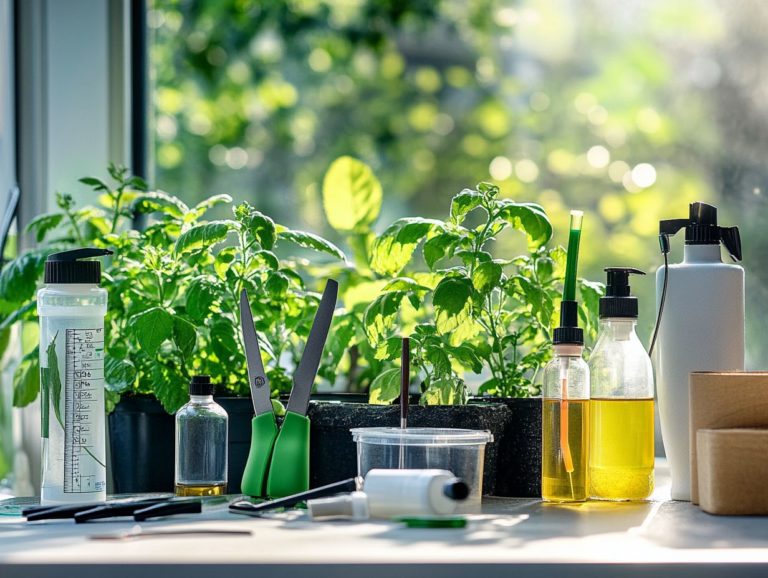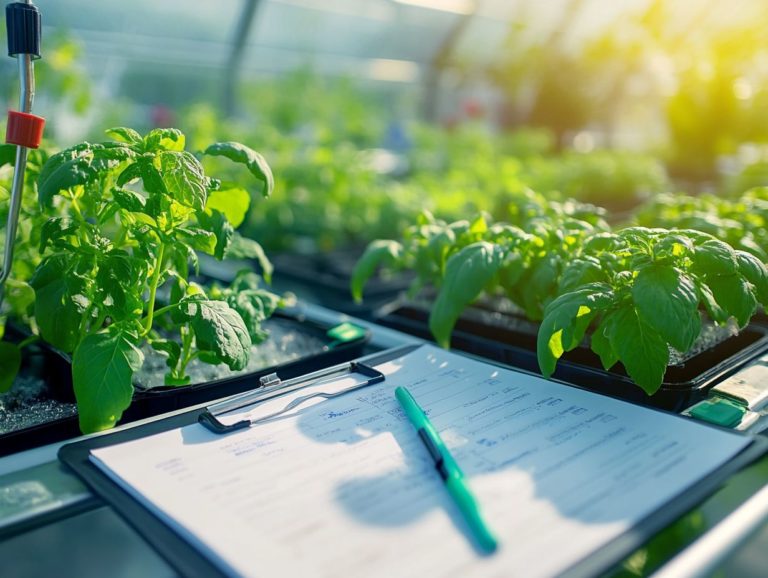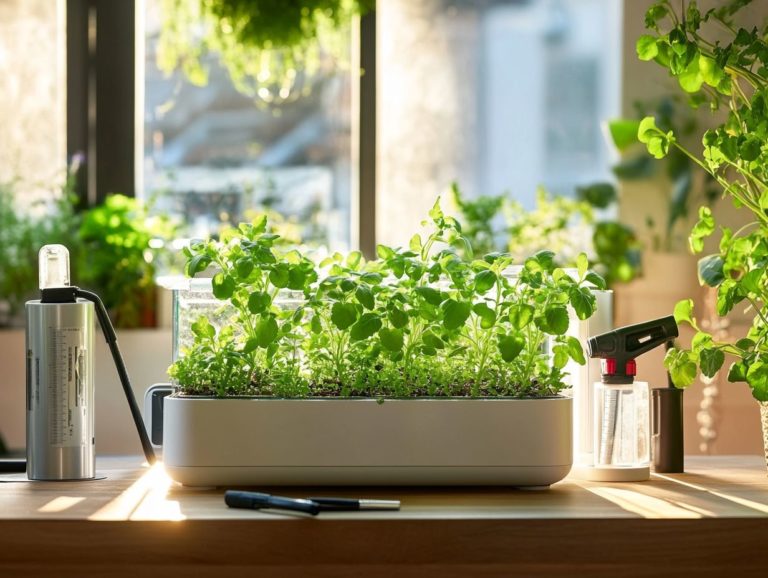Seasonal Maintenance Tips for Hydroponics
Hydroponics is transforming the way you cultivate food, presenting a soil-less alternative that can deliver remarkable results.
Just like any garden, these systems demand regular attention to truly thrive.
This article delves into the essentials of seasonal maintenance for hydroponics systems, underscoring the advantages of routine care while providing a handy maintenance checklist to keep you organized. You ll also find solutions for common issues that may arise, including those related to plant care and fish health.
With advanced tips at your disposal, you can maximize your yield and ensure your hydroponic garden flourishes throughout the year, especially during winter.
Contents
- Key Takeaways:
- Benefits of Seasonal Maintenance
- Seasonal Maintenance Checklist
- Troubleshooting Common Issues
- Advanced Tips for Optimal Performance
- Frequently Asked Questions
- What is hydroponic gardening?
- Why is seasonal maintenance important for hydroponics?
- What are some common seasonal maintenance tasks for hydroponics?
- When should I perform seasonal maintenance on my hydroponic system?
- Can I do the seasonal maintenance myself or do I need a professional?
- What are some signs that my hydroponic system may need seasonal maintenance?
Key Takeaways:
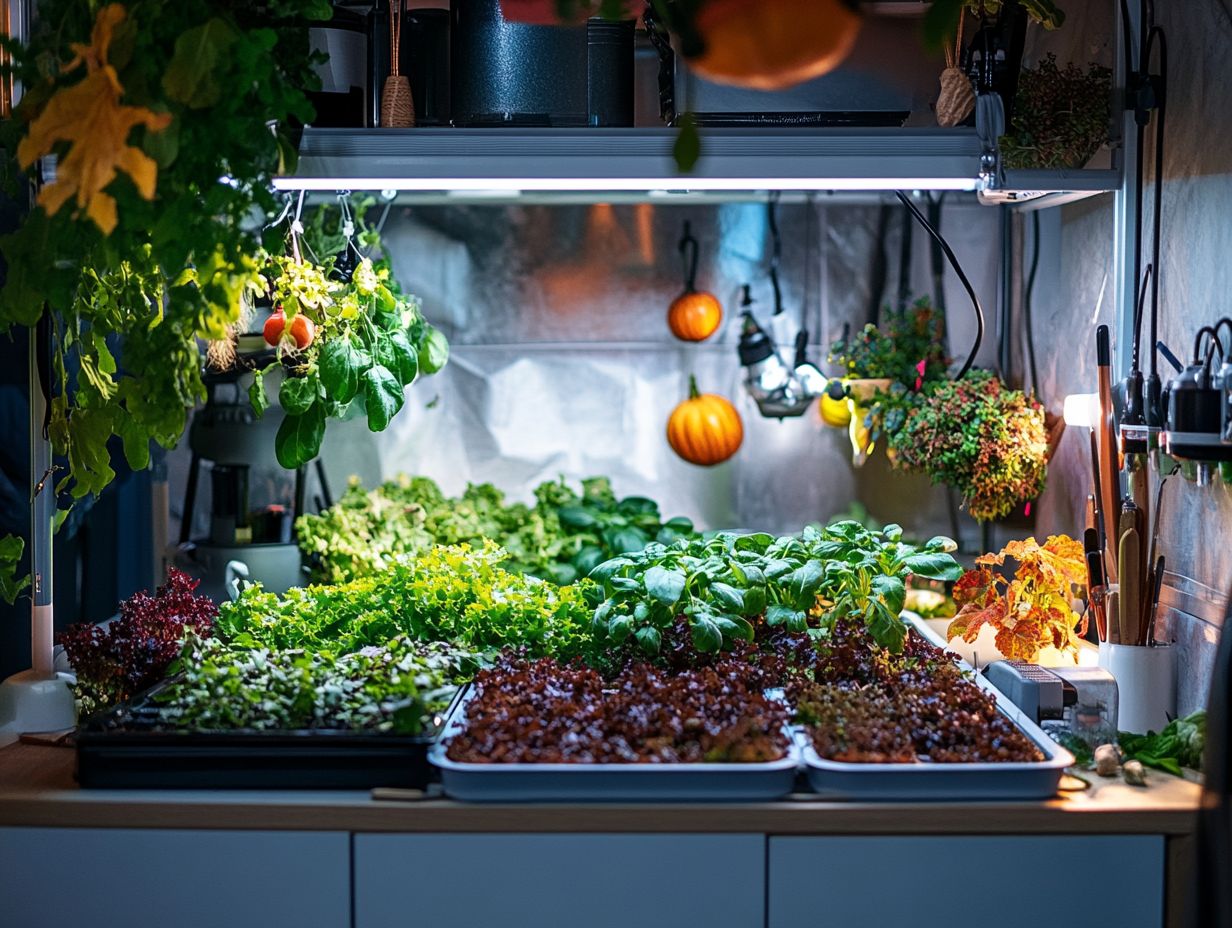
- Regular maintenance is key to maximizing the success of your hydroponic system.
- Include tasks like checking pH levels and cleaning filters in your maintenance checklist.
- Troubleshoot issues promptly to maintain a healthy environment for your plants and fish.
What is Hydroponics and How Does it Work?
Hydroponics stands as a cutting-edge method for cultivating plants without the need for soil. It employs a nutrient solution a mix of water and minerals that plants need to grow that delivers essential minerals directly to the roots.
In this innovative approach, you can create a well-controlled environment where water quality, pH levels, and ambient humidity are optimized for maximum nutrient uptake.
Hydroponic systems can take various forms, such as nutrient film techniques or deep water culture, all designed to provide the ideal conditions for photosynthesis and robust growth.
These systems offer distinct advantages that are increasingly attracting both commercial growers and home gardeners. For example, cultivating without soil allows for remarkable space efficiency, enabling urban environments to host vertical gardens or rooftop farms.
Hydroponically grown plants enjoy accelerated growth rates because they absorb nutrients more readily than those grown in soil. This enhanced capability leads to higher yields within shorter cultivation cycles, positioning hydroponics as not just a sustainable alternative but also a potentially lucrative agricultural option.
By minimizing the risk of soil-borne pests and diseases, hydroponics fosters healthier plants that require fewer chemical interventions, making it an appealing choice for conscientious growers.
Benefits of Seasonal Maintenance
Seasonal maintenance is key to keeping your plants and fish healthy in hydroponics. This ensures optimal growth conditions and enhances overall productivity.
By adhering to a regular plant care routine, including a meticulous maintenance checklist, you can address key factors such as water quality, ambient humidity, and nutrient levels that significantly influence plant health.
During the winter months, it s particularly important for you to focus on temperature management and light distribution to prevent stress in your plants and ensure the well-being of your fish.
Why Regular Maintenance is Important
Regular maintenance in hydroponics is essential for you to ensure optimal plant health and maximize nutrient uptake, as well as maintain an efficient water circulation system.
If you neglect factors like pH levels and temperature management, your plants may suffer from nutrient deficiencies or stress, which can lead to reduced yields and unhealthy growth.
A comprehensive maintenance checklist can be your best friend in staying on top of these crucial tasks.
Upkeep also plays a pivotal role in pest management, helping you prevent infestations that can quickly undermine all the hard work you’ve put into plant care.
By routinely monitoring water quality, you can keep harmful pathogens at bay, fostering a healthier environment for robust plant growth.
This holistic approach not only enhances the vitality of your plants but also contributes to a sustainable growing system, allowing you to achieve bountiful yields while minimizing the risks associated with neglect.
Investing time in maintenance ultimately pays off, creating a thriving ecosystem that supports your long-term success.
Seasonal Maintenance Checklist
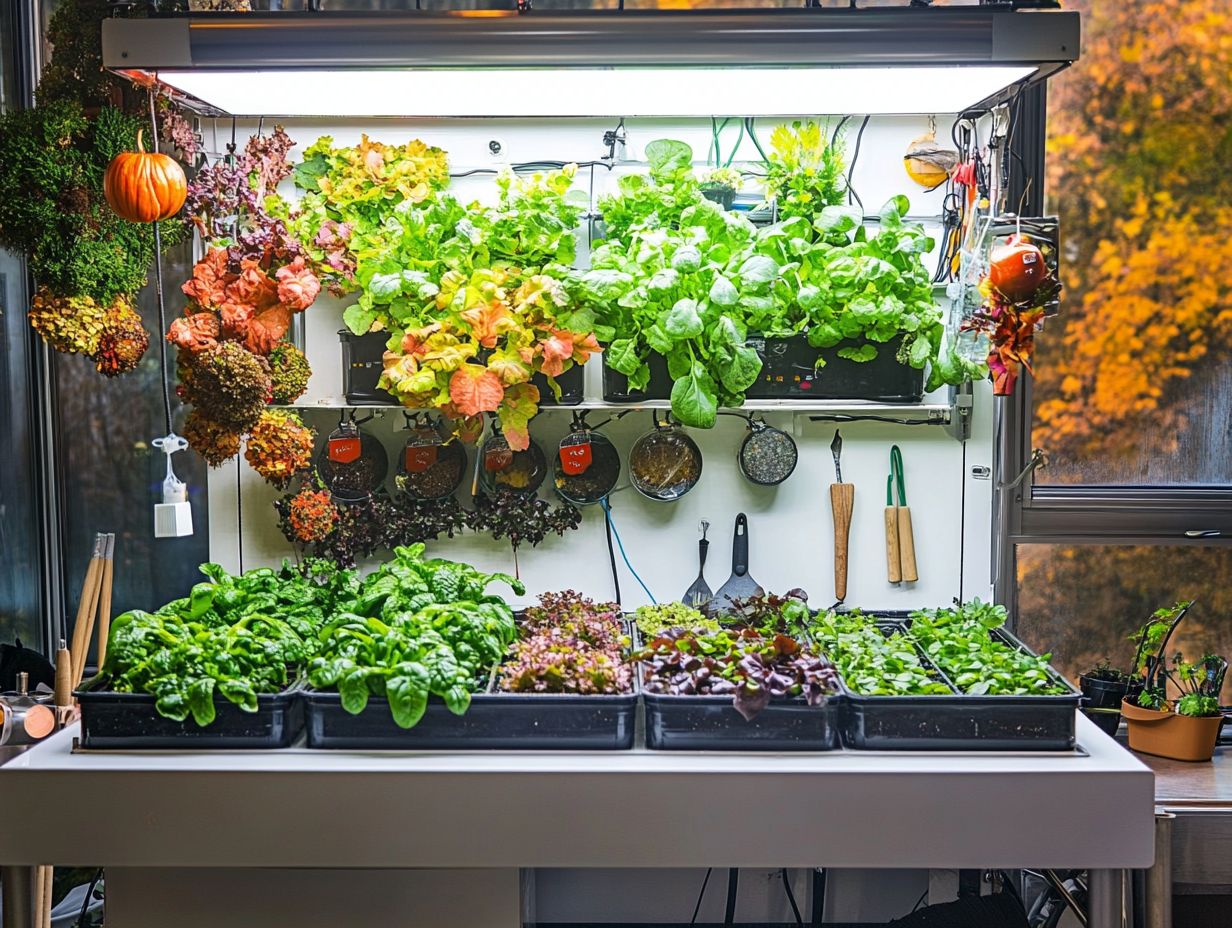
A seasonal maintenance checklist serves as an essential tool for you as a grower. It ensures that every essential aspect of your hydroponics system receives the attention it deserves, especially during seasonal transitions.
This checklist includes important tasks like monitoring water quality, managing temperature levels, and adjusting ambient humidity. Each of these plays a vital role in the overall health and vitality of your plants and fish.
By making seasonal adjustments, you can significantly enhance growth rates and health, particularly given the unique challenges presented by winter hydroponics.
What to Check and When
Understanding what to check and when is crucial for the success of your hydroponics system. This knowledge gives you the power to proactively tackle issues before they spiral out of control.
Regular inspections should include evaluating water quality with a pH meter a device that measures the acidity or alkalinity of water and closely monitoring temperature management. Both of these are vital for ensuring the nutrient solution remains effective. Maintaining the aeration system is equally critical for promoting healthy root development and optimal plant growth.
Additionally, routinely check nutrient solution levels and make adjustments as needed to prevent any deficiencies or toxicities.
Don’t overlook the condition of the growing medium. Ensuring it retains adequate moisture and has proper drainage can significantly impact your plants’ health. Conduct visual inspections for pests and diseases to catch problems early, fostering a more robust and productive hydroponic environment.
Troubleshooting Common Issues
Troubleshooting common issues in hydroponics is essential for ensuring that your plants thrive and remain productive throughout their growth cycle. You may encounter various problems stemming from factors that impact photosynthesis, such as insufficient light or nutrient deficiencies that impede nutrient uptake.
Effective pest management is crucial to maintaining plant health and preventing infestations that could jeopardize your yield. Act quickly to avoid setbacks!
Identifying and Solving Problems
Identifying and solving problems in hydroponics demands keen observation and a solid understanding of the system’s variables, such as pH levels and nutrient solution concentration. By regularly monitoring these factors, you can catch early signs of stress or deficiencies in your plants and implement timely pest management strategies to safeguard their health.
Solving these issues can boost your crop’s yield and quality. To hone these skills further, consider establishing a daily routine for checking and documenting key measurements of your growing medium and other critical factors.
Leveraging diagnostic tools like EC meters and pH testers will make this process more efficient. It s also advantageous to compare your results against established benchmarks for different plant species.
When you spot any abnormalities, taking immediate corrective actions such as adjusting nutrient ratios or fine-tuning environmental factors like light intensity and temperature can prevent minor issues from spiraling into major setbacks.
Additionally, engaging with online forums or local growers networks can provide you with invaluable insights into effective strategies tailored specifically to your unique system.
Advanced Tips for Optimal Performance

Discover advanced tips that can supercharge your plants growth rates and overall productivity. Techniques like utilizing liquid fertilizers and optimizing CO2 levels enhance nutrient uptake and maximize photosynthesis, leading to healthier, more vigorous plants.
Additionally, ensuring effective light distribution is crucial for achieving uniform growth across your entire hydroponics system.
Expert Strategies for Maximizing Yield
Employing expert strategies for maximizing yield in hydroponics requires a thorough method to both system management and plant care. Focus on optimizing water circulation and maintaining an efficient aeration system. These elements are crucial for distributing nutrient solutions effectively and ensuring robust root development.
Regularly monitor your plants and system conditions to boost your yields significantly. Integrating advanced techniques like pH monitoring, tailored lighting schedules, and precise nutrient balancing can take your plant growth and productivity to new heights.
Professionals often recommend high-quality substrates that promote optimal drainage and moisture retention, essential for strong root systems.
Utilizing integrated pest management, a method to control pests using natural methods instead of chemicals, allows you to protect your crops while minimizing chemical interventions. Each of these components works in harmony, creating an environment where your plants can truly thrive.
Understanding how these elements interact is essential for anyone looking to master hydroponic growing and unlock its full yield potential. Act now to ensure your plants reach their maximum potential!
Frequently Asked Questions
What is hydroponic gardening?
Hydroponic gardening is a method of growing plants without soil, using nutrient-rich solutions instead.
Why is seasonal maintenance important for hydroponics?
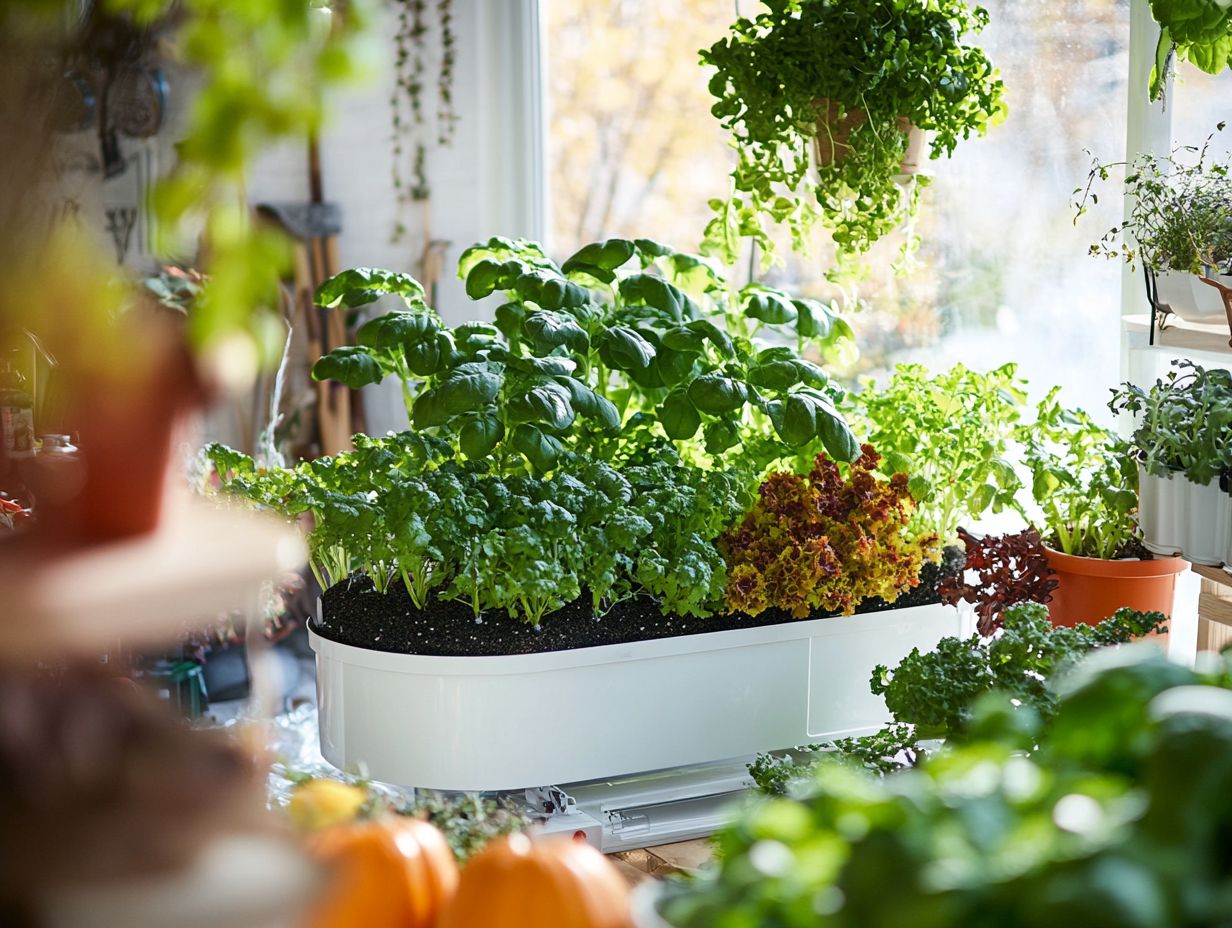
Seasonal maintenance helps ensure that your hydroponic system operates efficiently and produces healthy plants.
What are some common seasonal maintenance tasks for hydroponics?
- Check and adjust nutrient levels.
- Clean and replace filters.
- Look for signs of pests or diseases.
When should I perform seasonal maintenance on my hydroponic system?
The timing of seasonal maintenance depends on your specific setup and the plants you are growing. Generally, perform a full maintenance check at the start and end of each growing season.
Can I do the seasonal maintenance myself or do I need a professional?
With the right knowledge and equipment, you can perform seasonal maintenance on your hydroponic system yourself. However, if you’re unsure or need assistance, it’s best to consult a professional.
What are some signs that my hydroponic system may need seasonal maintenance?
Signs may include decreased plant growth, discoloration of leaves, unusual odors from the water or nutrient solution, and clogged filters. If you notice any of these, it is recommended to perform a maintenance check.



